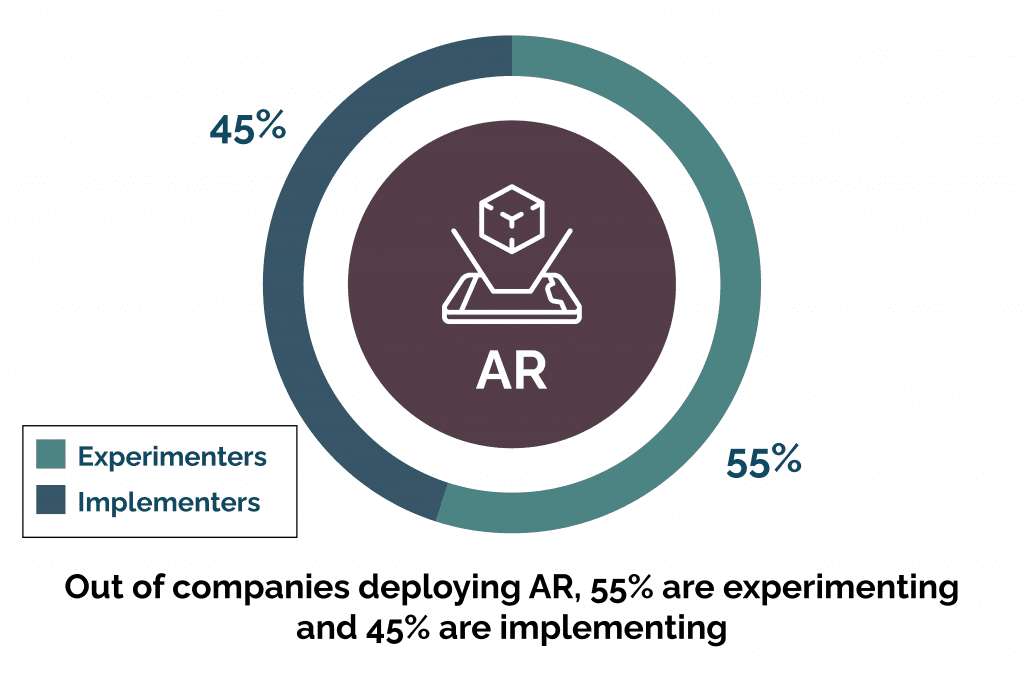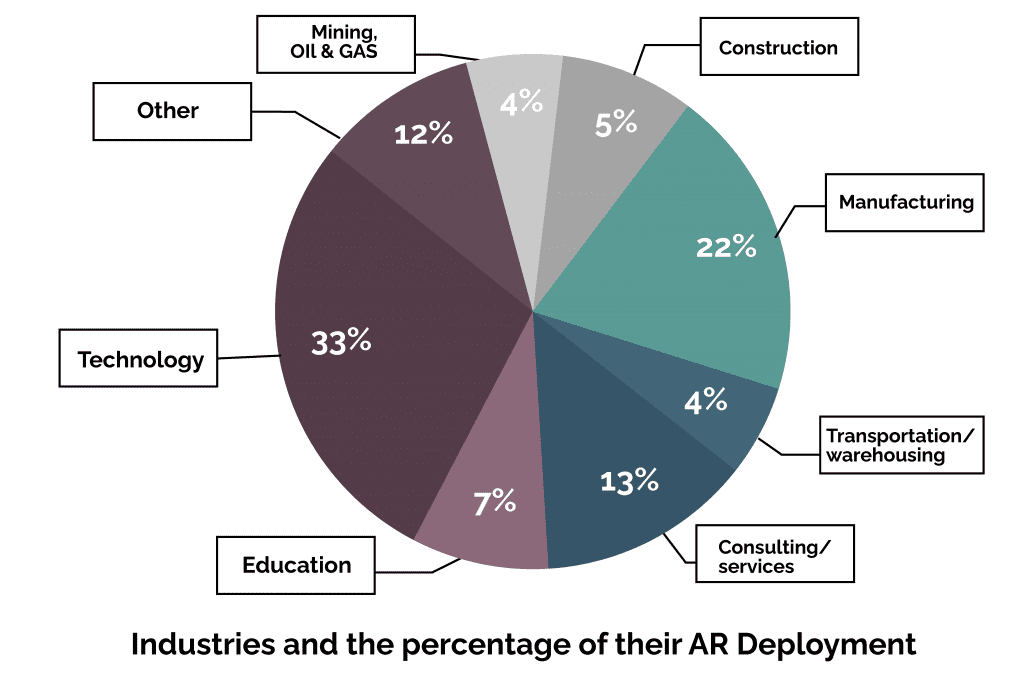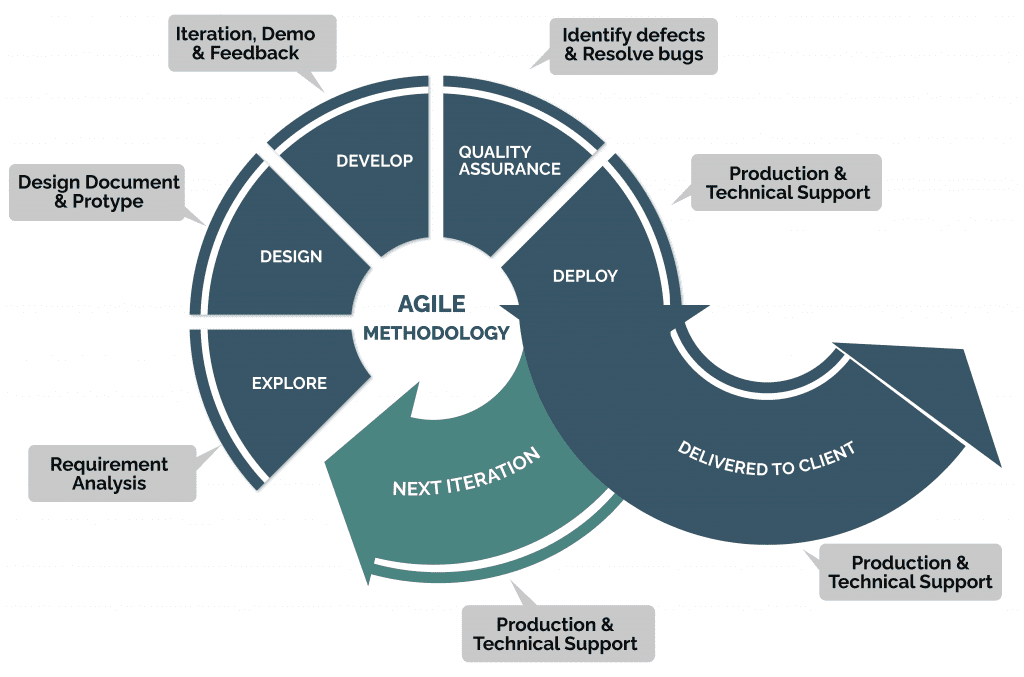Augmented Reality is expected to hit $61.39 billion by 2023, growing at a 55.71% CAGR. The ever-advancing capabilities of AR technology drive this explosive growth and shape its deployment for various business cases.
Before you start deploying your AR use cases, it’s essential to set the IT infrastructure to ensure complete support after the Exploring Stage in the AR Maturity Model. You also need to establish your budget for hardware (smart glasses), wireless network coverage, software, etc.
The deploying stage is exciting because organizations gain momentum and focus on using AR solutions to meet business challenges. When total value emerges, it enables organizations to optimize use cases. The deployment stage defines facts that were previously assumptions in the Exploration phase.
AR use cases at this stage respond to business needs in one or more specific departments across the organization. Simple AR solutions incorporate visual work instructions, video, initial collection & analysis of data collected. Solutions may also include advanced documentation work relating to various deployments.
According to Capgemini’s recent study, these are the percentages of AR Deployment being done currently in various industries.

 Agile Processes leading to AR Deployment
Agile Processes leading to AR Deployment
 The transition steps between the Exploring Stage to the Deploying Stage are summarized below.
The transition steps between the Exploring Stage to the Deploying Stage are summarized below.
- The Roadmap for the deployment stage is backed by the research done in the exploring stage. The Roadmap specifies which areas the enterprise wants to explore, the budget and costs, and the feasibility study for each step.
- Interested departments can jointly plan use case implementations and identify funding sources for AR work.
The different types of AR implementations considered during deployment are:
-
- Marker-based AR or Image Recognition-based AR provides more information about a scanned object after the user focuses on a pre-defined marker or sticker.
- A pre-defined room-scale AR application allows the user to walk into a room that has been pre-scanned and overlay a visual aesthetic showcasing various objects laid out in the scene.
- Plane projection / Gyroscopic augmented reality allows the user to detect a flat surface and scans that surface to use a pivot point or origin for projecting the user’s 3D model or object.
- Wearable-based augmented reality requires specific hardware to overlay objects in the user’s retina and offer more in-depth visuals with a field of view that will be present wherever the user looks.
- Establish a budget to explore the next stages of AR. The budget should include considerations for additional device hardware (such as smart glasses and expanded wireless network coverage). Costs associated with upkeep, maintenance, and support down the road also need to be factored in.
Estimating the AR App Development Cost is also vital in the Deployment Stage.
- Engage IT to provide the foundational IT infrastructure to support your AR use cases.
- Prioritize the use cases your team identified.
Activities of the Deployment Stage
Strategic Activities
- AR software and hardware platform strategies are laid out.
- One or more use cases being deployed to solve business problems.
- Single or multi-departmental deployments.
- Operating models and governance frameworks are established.
- AR value drivers are being refined as a result of real experience.
- Involvement of corporate IT
- Security evaluations
- Mobile device management strategy definition
Types of Strategies Involved
The AR deployment stage is influenced by these two types of AR exploring strategies. The budgeting, human resources involved, the level of involvement, technology stacks to be used, and more are decided.
- Reactive –This strategy relies on how an internal business issue or circumstance influences the AR exploring stage.
- Request-based –There is a specific request within the company from clients or internal departments to explore AR.
Technology Activities
- An AR software platform strategy is implemented or in the process of being rolled out.
- A use case-driven device strategy is established, including smartphones, tablets, and smart glasses.
- Video calling – The collaboration mechanism and tools between tech & experts, for example, are rolled out along with clearly defined objectives.
- Augmented task flows are laid out.
- The content strategy for AR is defined.
- Collect and act on AR analytics.
- Start to consider IoT use cases.
Content Activities
- Augmented Digital Task Flows are designed and executed.
- Select enterprise content is integrated.
- Existing 2D and 3D content assets are leveraged and new value created.
Budget Activities
- Discrete budgets for AR software and hardware are executed and available in various departments of the organization.
- Budgets are also set for security mechanisms, compliance, standardization, etc.
Areas Where AR Deployments (Early Stage) have been Successful
Gaming: One of the most recognizable AR deployment examples in mobile app gaming is Pokémon Go.
Marketing: Here, AR deployment comes in product placement, such as placing virtual Ikea furniture in your living room.
Retail: One successful deployment is the smart mirror that allows shoppers to virtually try on jewelry/clothes/accessories that they’re interested in without actually trying them on.
Factory: On assembly lines in factories, workers wearing AR glasses can have assembly instructions displayed to them step by step to increase accuracy and efficiency.
Warehouse: Workers in large warehouses use wearable AR technology to get directions to find products during the sorting and transport of goods, saving them time spent searching for the desired product/outcome and eliminating human error.
Aerospace &Defense: AR technology is being deployed in the aerospace and defense sectors, primarily in the form of Heads Up Displays (HUDs), which give pilots critical flight information right where and when they need it.
Education: AR technology is being deployed for education, especially in giving students more immersive and engaging lessons. It can also be more effectively used to train employees with more realistic work scenarios.
Tourism: AR deployed on Mobile apps can help tourists find directions and desirable destinations. AR could also translate street signs and be used in museums to make displays more engaging.
Conclusion
AR is an exciting technology with a broad spectrum of potential uses. Advances in embedded vision technology can be critically observed during deployment.
AR deployment creates the defining moment where the exploration stage’s success is realized to its partial or full potential. Enterprises can take a deep dive into the AR ocean and recognize their strengths and overcome any challenges effectively.
Radiant Digital can help you with your deployment initiatives to fully power up your AR prototypes and champion business use cases. Connect with us today.

